
精品课程生理学习题库 Female Reproductive System Histology Instructions: Select the single best answer to the numbered question. Question1 Maintenance of the orally acidic pl of the vaginal lun is important because the low l inhibits the growth of undesirable microorganisms such as yeasts.This normally acidic is the result of A.acid secretion by vaginal glands B.recovery of bicarbonate by blood vessels in the lamina propria C.the acidic nature of the carbohydrates in cervical mucus D.exchange of #for K+by the epithelial cells E bacterial metabolism of glycogen Question #2 All of the following statements about the syncytial trophoblast layer of placental villi are true EXCEPT A.divides and differentiates into cytotrophoblast cells C.is the source of urinary chorionic gonadotrphin (hG) D.mediates the exchange of oxygen and carbon dioxide E.is in direct contact with maternal blood Question#3 The mucosa of the uterine cervix is noted for its A.unchanging histological and functional characteristics through the uterine cycle B.ciliated and absorptive epithelial cells C.mucus secretion D.integrins that bind ligands on the trophoblast E responsiveness to luteinizing hormone (LGH) Question4 All of the following statements about granulosa cells during the follicular phase of the ovarian cycle are true EXCEPT A.secrete estrogen in response to stimulation by FSH B.surround a pria D.give rise to cells of the theca interna
精品课程生理学习题库 Female Reproductive System Histology Instructions: Select the single best answer to the numbered question. Question # 1 Maintenance of the normally acidic pH of the vaginal lumen is important because the low pH inhibits the growth of undesirable microorganisms such as yeasts. This normally acidic pH is the result of A. acid secretion by vaginal glands B. recovery of bicarbonate by blood vessels in the lamina propria C. the acidic nature of the carbohydrates in cervical mucus D. exchange of H+ for K+ by the epithelial cells E. bacterial metabolism of glycogen -------------------------------------------------------------------------------- Question # 2 All of the following statements about the syncytial trophoblast layer of placental villi are true EXCEPT A. divides and differentiates into cytotrophoblast cells B. secretes progesterone C. is the source of urinary chorionic gonadotrphin (hCG) D. mediates the exchange of oxygen and carbon dioxide E. is in direct contact with maternal blood -------------------------------------------------------------------------------- Question # 3 The mucosa of the uterine cervix is noted for its A. unchanging histological and functional characteristics through the uterine cycle B. ciliated and absorptive epithelial cells C. mucus secretion D. integrins that bind ligands on the trophoblast E. responsiveness to luteinizing hormone (LGH) -------------------------------------------------------------------------------- Question # 4 All of the following statements about granulosa cells during the follicular phase of the ovarian cycle are true EXCEPT A. secrete estrogen in response to stimulation by FSH B. surround a primary oocyte C. increase in number with time D. give rise to cells of the theca interna
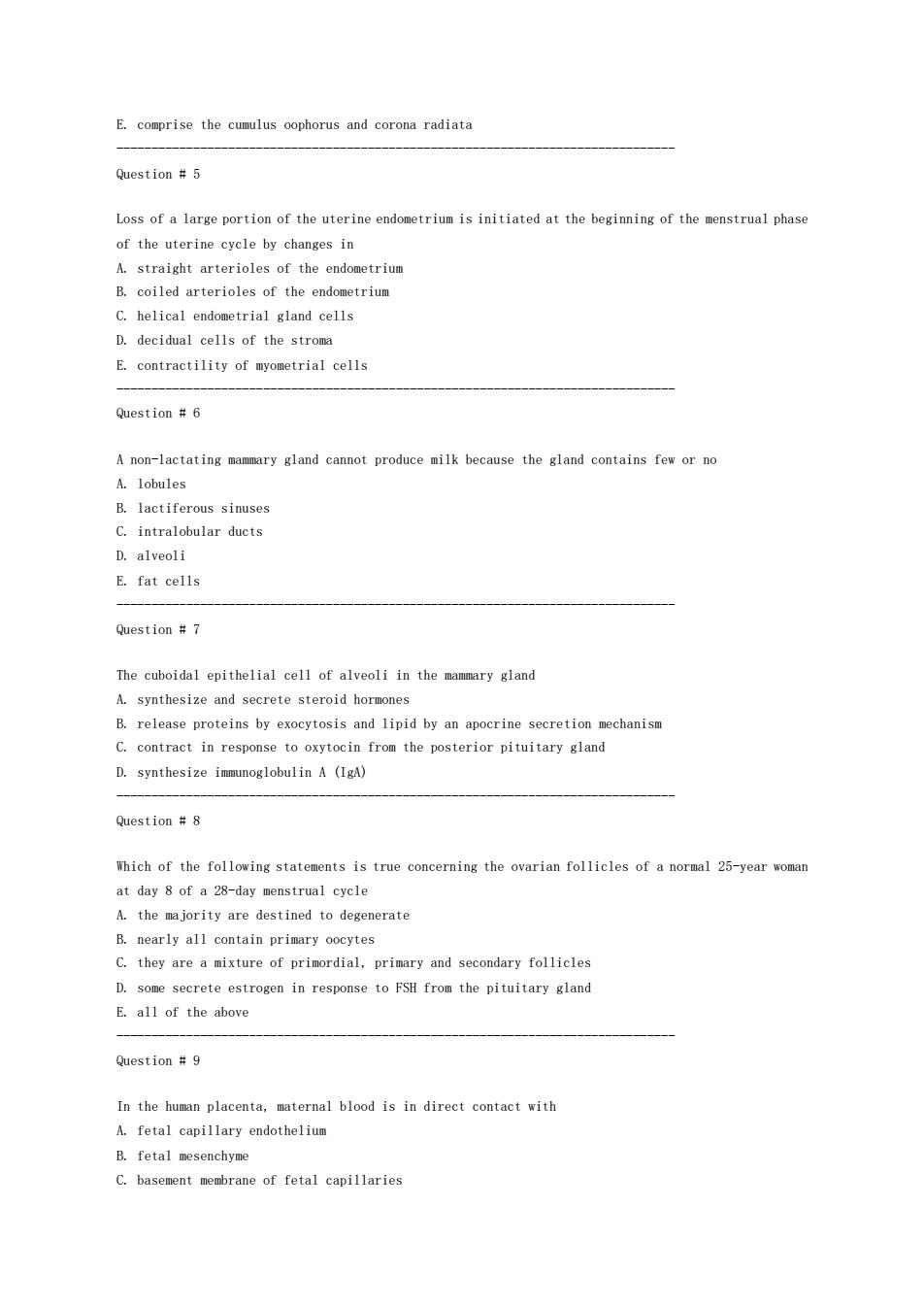
E.comprise the cumulus oophorus and corona radiata Question#5 Loss of a large portion of the uterine endometrium is initiated at the beginning of the menstrual phase of the uterine cycle by changes in A straight arterioles of the endometrium B.coiled arterioles of the endometrium C.helical endometrial gland cells decidual cells of the strom E.contractility of myometrial cells Question 6 A non-lactating mammary gland cannot produce milk because the gland contains few or no B.lactiferous sinuses C.intralobular ducts D.alveoli E fat cells Question#7 The cuboidal epithelial cell of alveoli in the mamary gland A.synthesize and secrete steroid hormones B.release proteins by exocytosis and lipid by an apocrine secretion mechanism C.contract in response to oxytocin from the posterior pituitary gland D.synthesize immunoglobulin A (IgA) Question 8 Which of the following statements is true concerning the ovarian follicles of a normal 25-vear woman at day 8 of a 28-day menstrual cycle A the majority are destined to degenerate arly all c ain primary oocytes C.they are a mixture of primordial,primary and secondary follicles D.some secrete estrogen in response to FSH from the pituitary gland E.all of the above In the human placenta,maternal blood is in direct contact with A fetal capillary endothelium B.fetal mesenchyme C.basement membrane of fetal capillaries
E. comprise the cumulus oophorus and corona radiata -------------------------------------------------------------------------------- Question # 5 Loss of a large portion of the uterine endometrium is initiated at the beginning of the menstrual phase of the uterine cycle by changes in A. straight arterioles of the endometrium B. coiled arterioles of the endometrium C. helical endometrial gland cells D. decidual cells of the stroma E. contractility of myometrial cells -------------------------------------------------------------------------------- Question # 6 A non-lactating mammary gland cannot produce milk because the gland contains few or no A. lobules B. lactiferous sinuses C. intralobular ducts D. alveoli E. fat cells -------------------------------------------------------------------------------- Question # 7 The cuboidal epithelial cell of alveoli in the mammary gland A. synthesize and secrete steroid hormones B. release proteins by exocytosis and lipid by an apocrine secretion mechanism C. contract in response to oxytocin from the posterior pituitary gland D. synthesize immunoglobulin A (IgA) -------------------------------------------------------------------------------- Question # 8 Which of the following statements is true concerning the ovarian follicles of a normal 25-year woman at day 8 of a 28-day menstrual cycle A. the majority are destined to degenerate B. nearly all contain primary oocytes C. they are a mixture of primordial, primary and secondary follicles D. some secrete estrogen in response to FSH from the pituitary gland E. all of the above -------------------------------------------------------------------------------- Question # 9 In the human placenta, maternal blood is in direct contact with A. fetal capillary endothelium B. fetal mesenchyme C. basement membrane of fetal capillaries
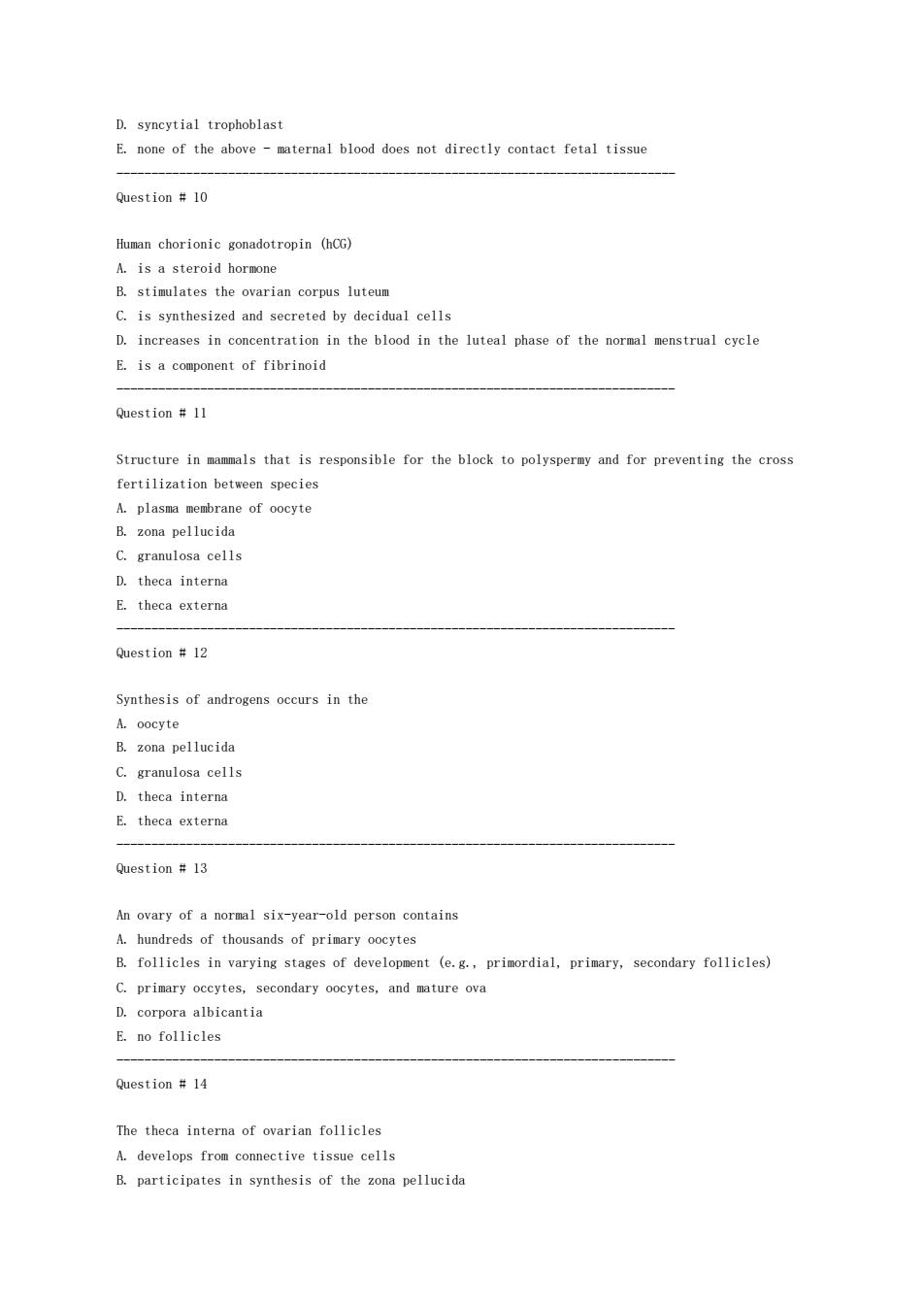
D.syncytial trophoblast E none of the above-maternal blood does not directly contact fetal tissue Question#10 Human chorionic gonadotropin (hCG) A is a steroid hormone B.stimulates the ovarian corpus luteum C.is synthesized and secreted by decidual cells increases in concentration in the blood in the luteal phase of the nornal menstrual cycle E.is a component of fibrinoid Question 11 Structure in amals that is responsible for the block to polyspermy and for preventing the cross fertilization between species A.plasma nembrane of oocyte B.zona pellucida C.granulosa cells D.theca interna E theca externa Question 12 Synthesis of androgens occurs in the A oocyte B.zona pellucida C.granulosa cells D.theca interna E.theca externa Question 13 An ovary of six-yearold person contains A.hundreds s of thousands of primary oocytes B.follicles in varying stages of development (e.g,primordial,primary,secondary follicles) C.primary occytes,secondary oocytes,and mature ova D.corpora albicantia E no follicles Question#14 The theca interna of ovarian follicles A.develops from connective tissue cells B participates in synthesis of the zona pellucida
D. syncytial trophoblast E. none of the above - maternal blood does not directly contact fetal tissue -------------------------------------------------------------------------------- Question # 10 Human chorionic gonadotropin (hCG) A. is a steroid hormone B. stimulates the ovarian corpus luteum C. is synthesized and secreted by decidual cells D. increases in concentration in the blood in the luteal phase of the normal menstrual cycle E. is a component of fibrinoid -------------------------------------------------------------------------------- Question # 11 Structure in mammals that is responsible for the block to polyspermy and for preventing the cross fertilization between species A. plasma membrane of oocyte B. zona pellucida C. granulosa cells D. theca interna E. theca externa -------------------------------------------------------------------------------- Question # 12 Synthesis of androgens occurs in the A. oocyte B. zona pellucida C. granulosa cells D. theca interna E. theca externa -------------------------------------------------------------------------------- Question # 13 An ovary of a normal six-year-old person contains A. hundreds of thousands of primary oocytes B. follicles in varying stages of development (e.g., primordial, primary, secondary follicles) C. primary occytes, secondary oocytes, and mature ova D. corpora albicantia E. no follicles -------------------------------------------------------------------------------- Question # 14 The theca interna of ovarian follicles A. develops from connective tissue cells B. participates in synthesis of the zona pellucida
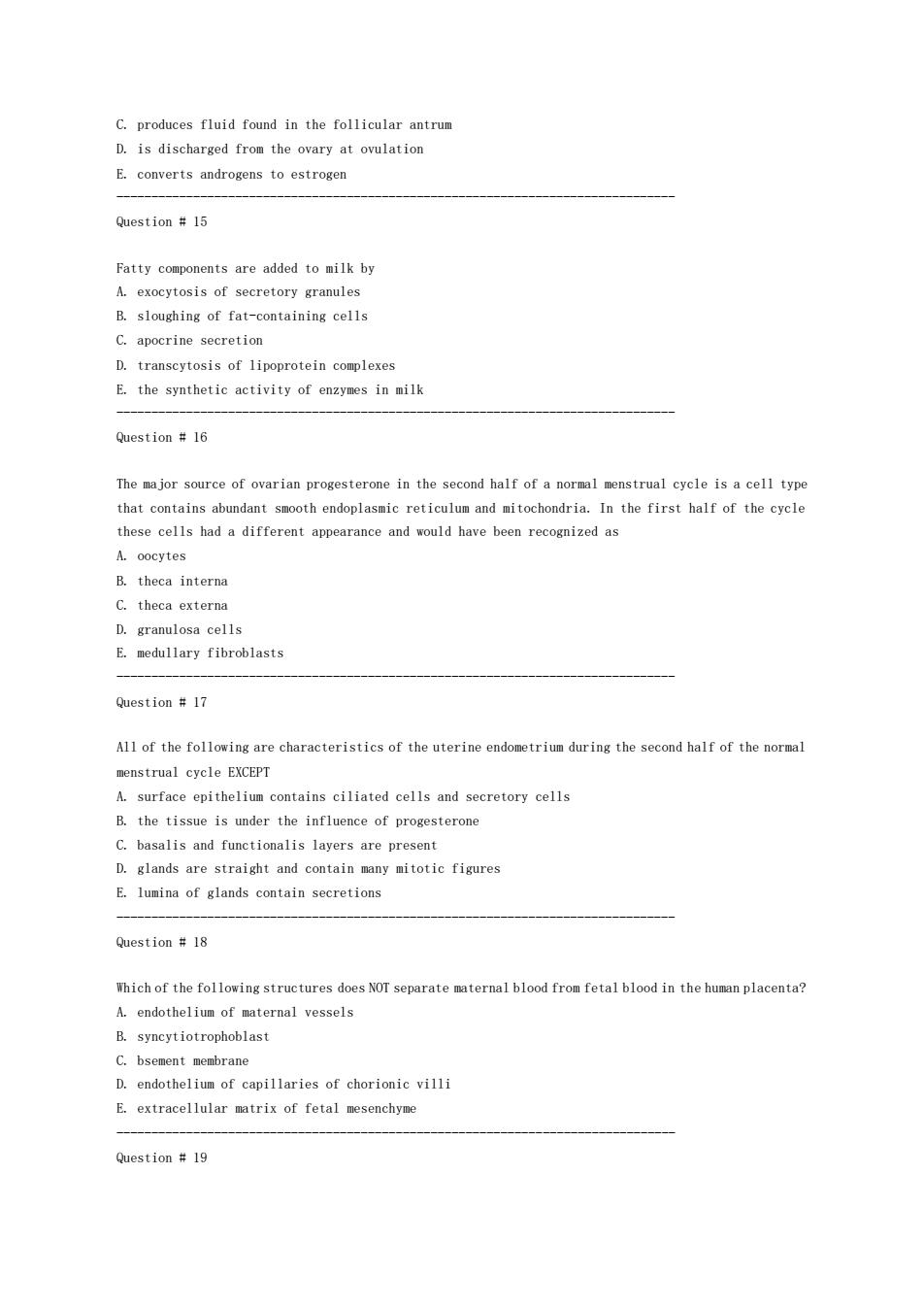
C.produces fluid found in the follicular antrum D.is discharged fron the ovary at ovulation E.converts androgens to estrogen Question 15 Fatty components are added to milk by A exoeytosis of secretory granules B.sloughing of fat-containing cells apocri e secretion D.transcytosis of lipoprotein complexes E the synthetic activity of enzymes in milk Question #16 that contains abundant smooth endoplasmic reticulum and mitochondria.In the first half of the cycle these cells had a different appearance and would have been recognized as A oocytes B.theca interna C.theca externa D.granulosa cells E.medullary fibroblasts Question #17 All of the following are characteristics of the uterine endometrium during the second half of the normal enstrual cycle EXCEPT A.surface epithelium contains ciliated cells and secretory cells B.the tissue is under the influence of progesterone C.basalis and functionalis lavers are present D.glands are straight and contain many mitotic figures E lumina of glands contain secretions Which of the following structures does NOT separate naternal blood from fetal blood in the hunan placenta? A.endothelium of maternal vessels B.syncytiotrophoblast endotheli of capillaries of chorinic villi E.extracellular matrix of fetal mesenchyme Question 19
C. produces fluid found in the follicular antrum D. is discharged from the ovary at ovulation E. converts androgens to estrogen -------------------------------------------------------------------------------- Question # 15 Fatty components are added to milk by A. exocytosis of secretory granules B. sloughing of fat-containing cells C. apocrine secretion D. transcytosis of lipoprotein complexes E. the synthetic activity of enzymes in milk -------------------------------------------------------------------------------- Question # 16 The major source of ovarian progesterone in the second half of a normal menstrual cycle is a cell type that contains abundant smooth endoplasmic reticulum and mitochondria. In the first half of the cycle these cells had a different appearance and would have been recognized as A. oocytes B. theca interna C. theca externa D. granulosa cells E. medullary fibroblasts -------------------------------------------------------------------------------- Question # 17 All of the following are characteristics of the uterine endometrium during the second half of the normal menstrual cycle EXCEPT A. surface epithelium contains ciliated cells and secretory cells B. the tissue is under the influence of progesterone C. basalis and functionalis layers are present D. glands are straight and contain many mitotic figures E. lumina of glands contain secretions -------------------------------------------------------------------------------- Question # 18 Which of the following structures does NOT separate maternal blood from fetal blood in the human placenta? A. endothelium of maternal vessels B. syncytiotrophoblast C. bsement membrane D. endothelium of capillaries of chorionic villi E. extracellular matrix of fetal mesenchyme -------------------------------------------------------------------------------- Question # 19
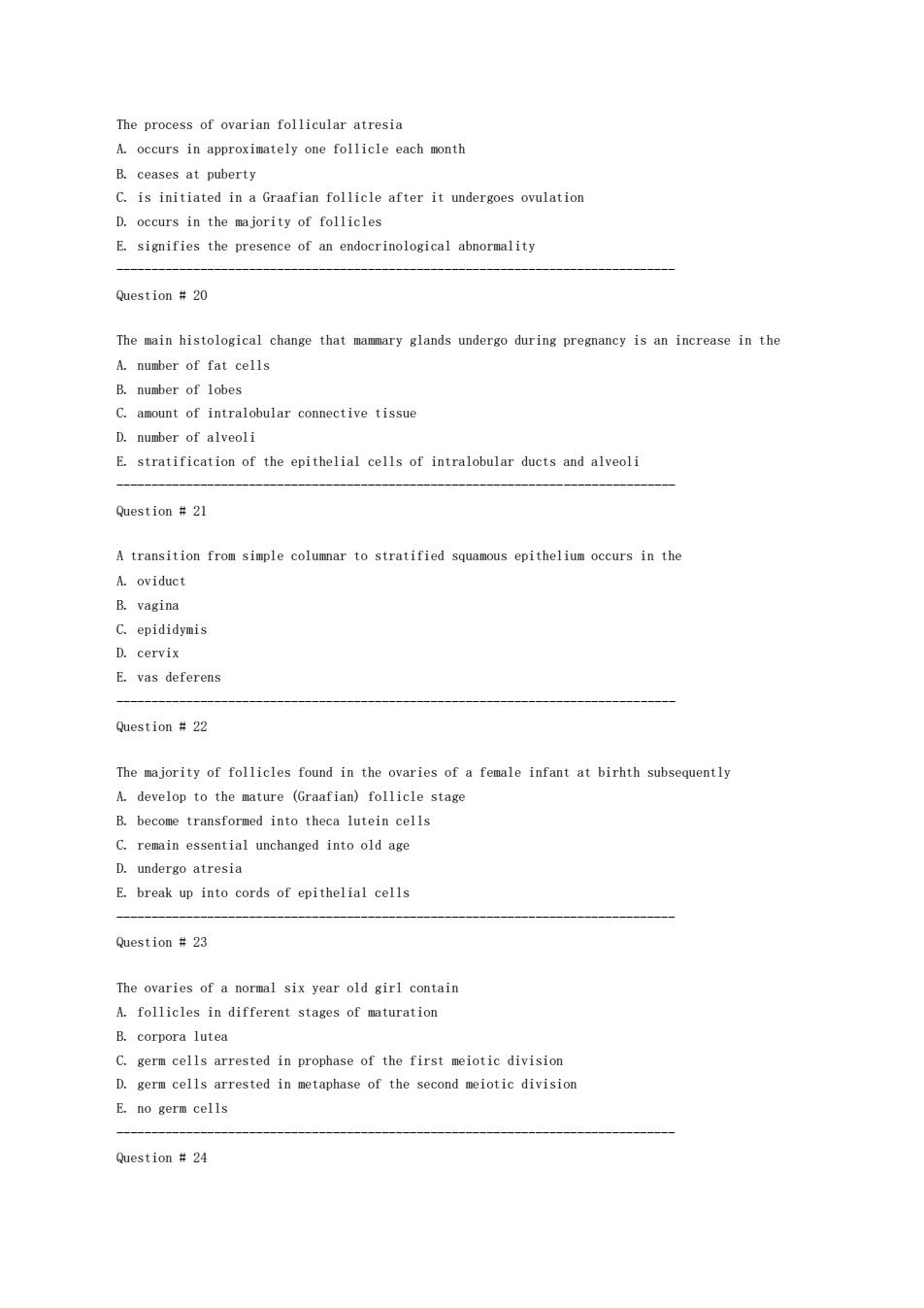
The process of ovarian follicular atresia ceases at puberty C.is initiated in a Graafian follicle after it undergoes ovulation D.occurs in the majority of follicles E signifies the presence of an endocrinological abnormality Question#20 The min histological change that amary glands undergo during pregnancy is an increase in the A.number of fat cells B.number of lobes C.anount of intralobular connective tissue D.number of alveoli Estratification of the epithelial cells of intralobular ducts and alveoli Question 21 A transition from simple columar to stratified squamous epithelium occurs in the A oviduct vagin C.epididymis D.cervix E vas deferens Question#22 The mjority of follicles found in the ovaries ofa femle infant at birhth subsequently A develop to the mature (Graafian)follicle stage B.become transformed into theca lutein cells C.remain essential unchanged into old age D.undergo atresia E break up into cords of epithelial cells Question 23 The ovaries of a normal six year old girl contain A follicles in different stages of maturation B.corpora lutea in prophase of the first eiotic divisio D.germ cells arrested in metaphase of the second meiotic divisio E.no germ cells Question#24
The process of ovarian follicular atresia A. occurs in approximately one follicle each month B. ceases at puberty C. is initiated in a Graafian follicle after it undergoes ovulation D. occurs in the majority of follicles E. signifies the presence of an endocrinological abnormality -------------------------------------------------------------------------------- Question # 20 The main histological change that mammary glands undergo during pregnancy is an increase in the A. number of fat cells B. number of lobes C. amount of intralobular connective tissue D. number of alveoli E. stratification of the epithelial cells of intralobular ducts and alveoli -------------------------------------------------------------------------------- Question # 21 A transition from simple columnar to stratified squamous epithelium occurs in the A. oviduct B. vagina C. epididymis D. cervix E. vas deferens -------------------------------------------------------------------------------- Question # 22 The majority of follicles found in the ovaries of a female infant at birhth subsequently A. develop to the mature (Graafian) follicle stage B. become transformed into theca lutein cells C. remain essential unchanged into old age D. undergo atresia E. break up into cords of epithelial cells -------------------------------------------------------------------------------- Question # 23 The ovaries of a normal six year old girl contain A. follicles in different stages of maturation B. corpora lutea C. germ cells arrested in prophase of the first meiotic division D. germ cells arrested in metaphase of the second meiotic division E. no germ cells -------------------------------------------------------------------------------- Question # 24
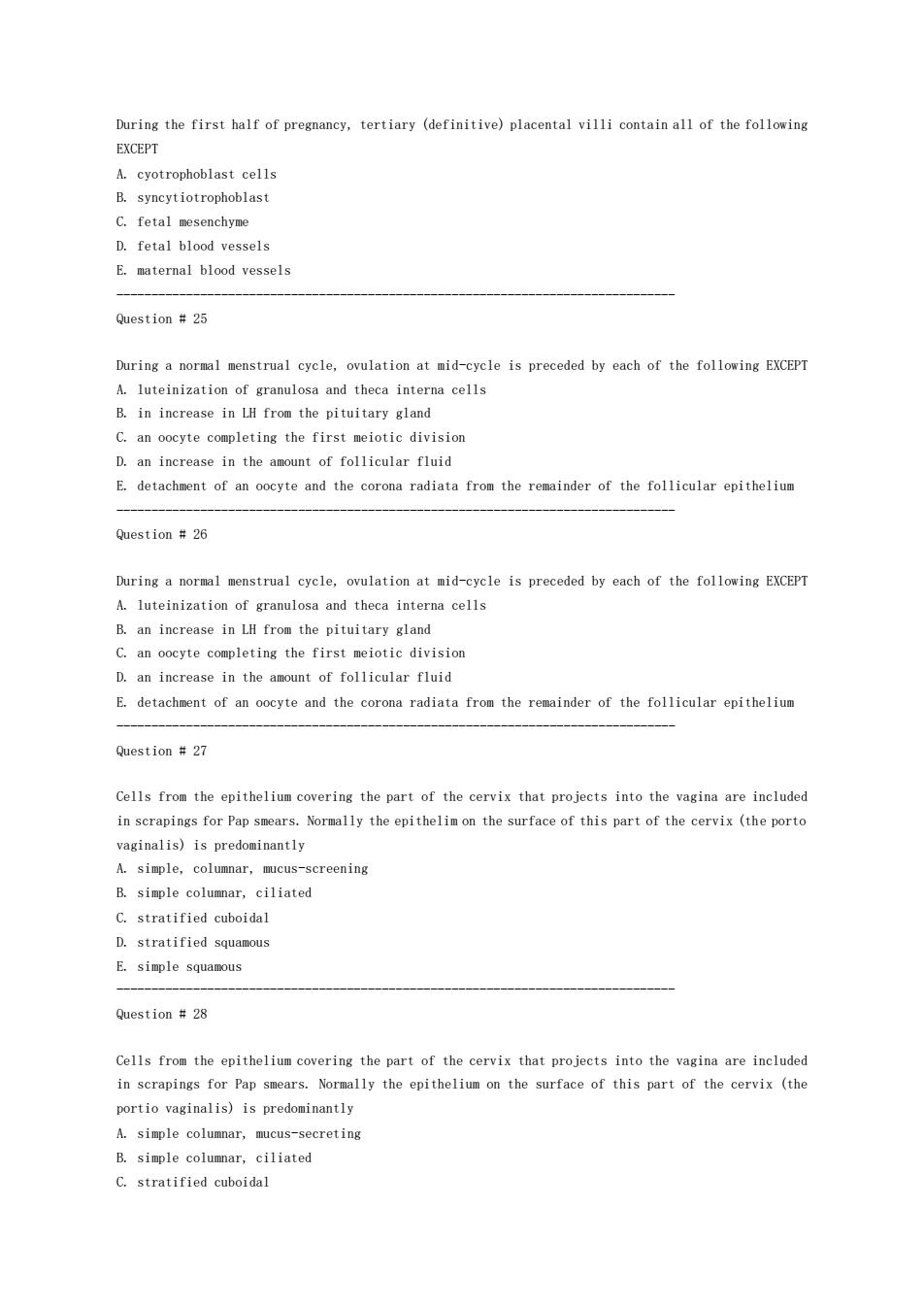
During the first half of pregnancy.tertiary (definitive)placental villi contain all of the following EXCEPT B.syncytiotrophoblast C.fetal mesenchyme D.fetal blood vessels E maternal blood vessels Question#25 During a normal menstrual cycle,ovulation at mid-cycle is preceded by each of the following EXCEPT A.luteinization of granulosa and theca interna cells B.in increase in LH from the pituitary gland C.an oocyte coleting the first eiotic division D.an increase in the amount of follicular fluid E.detachment of an oocyte and the corona radiata from the remainder of the follicular epithelium Question 26 During a normal menstrual cycle.ovulation at mid-cycle is preceded by each of the following EXCEPT A luteinization of granulosa and theca interna cells B.an increase in LH from the pituitary gland C.an oocyte completing the first meiotic divisio D.an increase in the amount of follicular fluid E.detachment of an oocyte and the corona radiata from the remainder of the follicular epithelium Question#27 Cells from the epithelium covering the part of the cervix that projects into the vagina are included in scrapings for Pap smears.Normally the epithelim on the surface of this part of the cervix (the porto vaginalis)is predominantly A.simple,colunnar,mucus-screening B.simple columpar.ciliated C.stratified cuboidal D.stratified squamous E.simple squamous Question 28 Cells from the epitheliu covering the part of the cervix that projects into the vagin a are included in scrapings for Pap smears.Normally the epitheliu on the surface of this part of the cervix (the portio vaginalis)is predominantly A simple columnar,mucus-secreting B.simple columnar,ciliated C.stratified cuboidal
During the first half of pregnancy, tertiary (definitive) placental villi contain all of the following EXCEPT A. cyotrophoblast cells B. syncytiotrophoblast C. fetal mesenchyme D. fetal blood vessels E. maternal blood vessels -------------------------------------------------------------------------------- Question # 25 During a normal menstrual cycle, ovulation at mid-cycle is preceded by each of the following EXCEPT A. luteinization of granulosa and theca interna cells B. in increase in LH from the pituitary gland C. an oocyte completing the first meiotic division D. an increase in the amount of follicular fluid E. detachment of an oocyte and the corona radiata from the remainder of the follicular epithelium -------------------------------------------------------------------------------- Question # 26 During a normal menstrual cycle, ovulation at mid-cycle is preceded by each of the following EXCEPT A. luteinization of granulosa and theca interna cells B. an increase in LH from the pituitary gland C. an oocyte completing the first meiotic division D. an increase in the amount of follicular fluid E. detachment of an oocyte and the corona radiata from the remainder of the follicular epithelium -------------------------------------------------------------------------------- Question # 27 Cells from the epithelium covering the part of the cervix that projects into the vagina are included in scrapings for Pap smears. Normally the epithelim on the surface of this part of the cervix (the porto vaginalis) is predominantly A. simple, columnar, mucus-screening B. simple columnar, ciliated C. stratified cuboidal D. stratified squamous E. simple squamous -------------------------------------------------------------------------------- Question # 28 Cells from the epithelium covering the part of the cervix that projects into the vagina are included in scrapings for Pap smears. Normally the epithelium on the surface of this part of the cervix (the portio vaginalis) is predominantly A. simple columnar, mucus-secreting B. simple columnar, ciliated C. stratified cuboidal
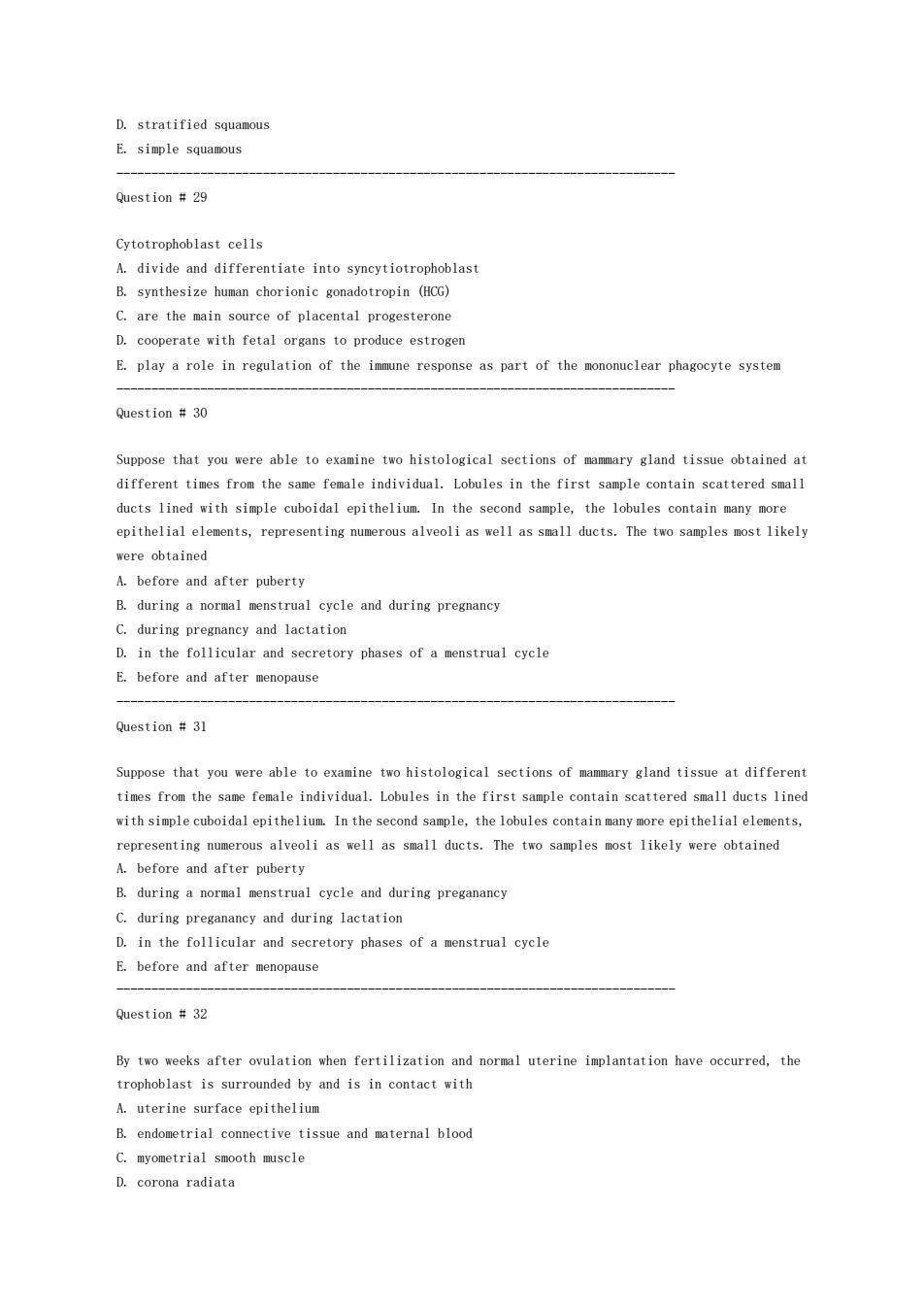
D.stratified squamous Esimple squamous Question#29 Cytotrophoblast cells A divide and differentiate into syncytiotrophoblast B.synthesize human chorionic gonadotropin (HCG) C.are the min source of placental progesterone cooperate with fetal organs to produce estrogen E.play a role in regulation of the immune response as part of the mononuclear phagocyte system Question 30 Suppose that you were able to examine two histological sections of mammary gland tissue obtained at different times from the sane female individual.Lobules in the first sample contain scattered seall ducts lined with simple cuboidal epithelium.In the second sanple,the lobules contain many more epithelial elements,representing numerous alveoli as well as small ducts.The two sarples most likely were obtained A before and after puberty B.during a normal rual cycle and during pregnancy C.during pregnancy and lactation D.in the follicular and secretory phases of a menstrual cycle E before and after menopause Suppose that you ere able to histological sections of ary gland tissue at differen female individual.Lobules in the first sarple contain scattered small ducts line with simple cuboidal epithelium.In the second sample,the lobules contain many more epithelial elements. representing numerous alveoli as well as small ducts.The two samples most likely were obtained A.before and after puberty B.during a normal menstrual cycle and during preganancy C.during preganancy and during lactation D.in the follicular and secretory phases of a menstrual cycle E.before and after menopause Question#32 trophoblast is surrounded by and is in contact with A.uterine surface epithelium B.endometrial connective tissue and maternal blood corona radiata
D. stratified squamous E. simple squamous -------------------------------------------------------------------------------- Question # 29 Cytotrophoblast cells A. divide and differentiate into syncytiotrophoblast B. synthesize human chorionic gonadotropin (HCG) C. are the main source of placental progesterone D. cooperate with fetal organs to produce estrogen E. play a role in regulation of the immune response as part of the mononuclear phagocyte system -------------------------------------------------------------------------------- Question # 30 Suppose that you were able to examine two histological sections of mammary gland tissue obtained at different times from the same female individual. Lobules in the first sample contain scattered small ducts lined with simple cuboidal epithelium. In the second sample, the lobules contain many more epithelial elements, representing numerous alveoli as well as small ducts. The two samples most likely were obtained A. before and after puberty B. during a normal menstrual cycle and during pregnancy C. during pregnancy and lactation D. in the follicular and secretory phases of a menstrual cycle E. before and after menopause -------------------------------------------------------------------------------- Question # 31 Suppose that you were able to examine two histological sections of mammary gland tissue at different times from the same female individual. Lobules in the first sample contain scattered small ducts lined with simple cuboidal epithelium. In the second sample, the lobules contain many more epithelial elements, representing numerous alveoli as well as small ducts. The two samples most likely were obtained A. before and after puberty B. during a normal menstrual cycle and during preganancy C. during preganancy and during lactation D. in the follicular and secretory phases of a menstrual cycle E. before and after menopause -------------------------------------------------------------------------------- Question # 32 By two weeks after ovulation when fertilization and normal uterine implantation have occurred, the trophoblast is surrounded by and is in contact with A. uterine surface epithelium B. endometrial connective tissue and maternal blood C. myometrial smooth muscle D. corona radiata
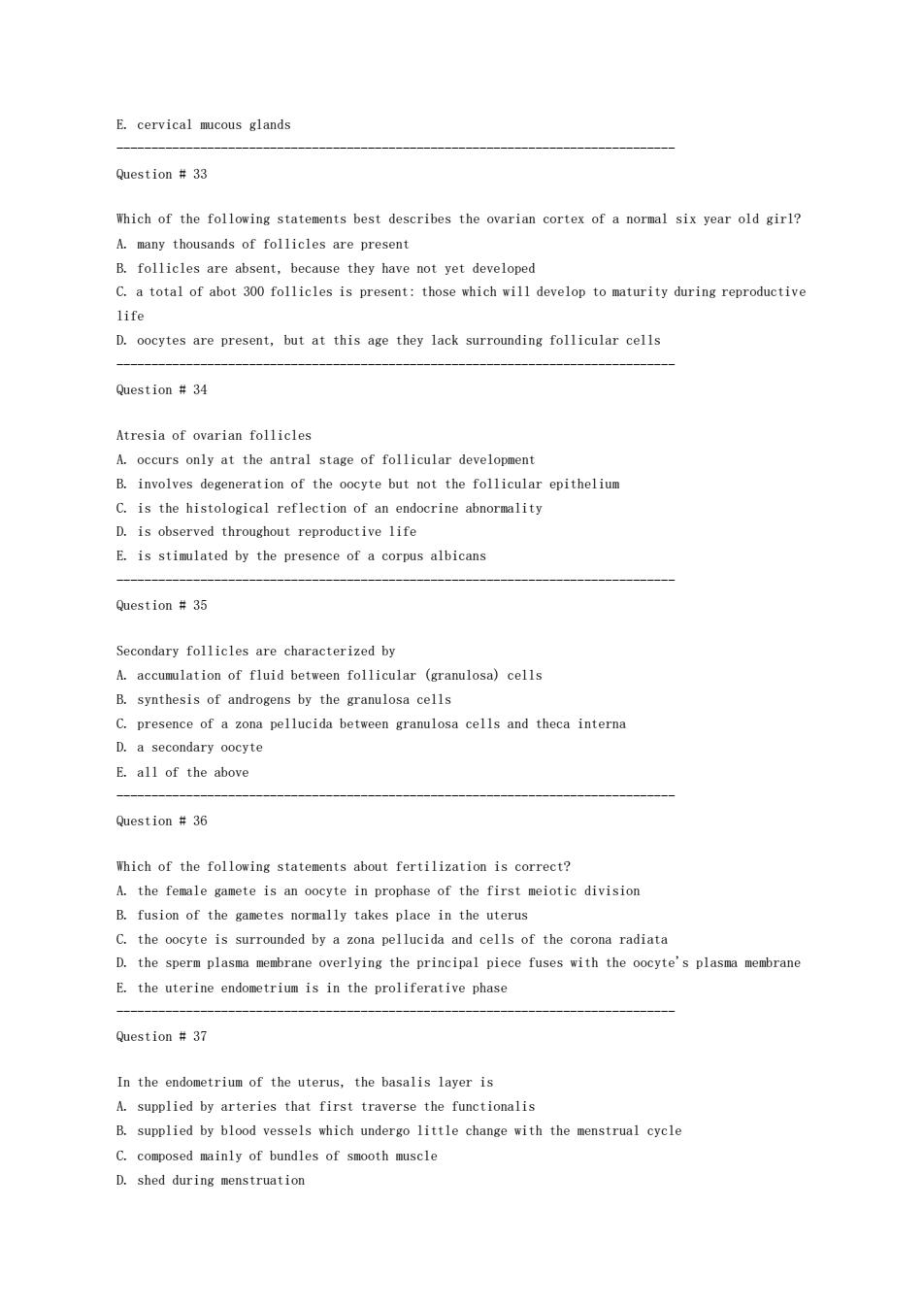
E.cervical mucous glands Question#33 Which of the following statements best describes the ovarian cortex of a normal six year old girl? A.many thousands of follicles are present B.follicles are absent,because they have not yet developed C.a total of abot 300 follicles is present:those which will develop to maturity during reproductive life cocytes are present,but at this age they lack surrounding follicular cells Question#34 Atresia of ovarian follicles A occurs only at the antral stage of follicular development B.involves degeneration of the ocyte but not the follicular epitheliu C.is the histological reflection of an endocrine abnormality D.is observed throughout reproductive life E.is stimulated by the presence of a corpus albicans Question #35 Secondary follicles are characterized by A.accumulation of fluid between follicular (granulosa)cells B.synthesis of androgens by the granulosa cells C.presence of a zona pellucida between granulosa cells and theca interna D.a secondary oocyte E all of the above Question 36 Which of the following statements about fertilization is correct? A.the female gamete is an oocyte in prophase of the first meiotic division B.fusion of the gametes normally takes place in the uterus C the surrounded by a o pellucida and ce of thecoro radiata D.the sperm plasma embrane overlying the principal piece fuses with the oocyte's plasna aenbrane E.the uterine endometrium is in the proliferative phase Question#37 In the endometrium of the uterus,the basalis layer is supplied by arteries that first traverse the functionalis B.supplied by blood vessels which undergo little change with the nenstrual cycle C.composed mainly of bundles of saooth muscle D.shed during nenstruation
E. cervical mucous glands -------------------------------------------------------------------------------- Question # 33 Which of the following statements best describes the ovarian cortex of a normal six year old girl? A. many thousands of follicles are present B. follicles are absent, because they have not yet developed C. a total of abot 300 follicles is present: those which will develop to maturity during reproductive life D. oocytes are present, but at this age they lack surrounding follicular cells -------------------------------------------------------------------------------- Question # 34 Atresia of ovarian follicles A. occurs only at the antral stage of follicular development B. involves degeneration of the oocyte but not the follicular epithelium C. is the histological reflection of an endocrine abnormality D. is observed throughout reproductive life E. is stimulated by the presence of a corpus albicans -------------------------------------------------------------------------------- Question # 35 Secondary follicles are characterized by A. accumulation of fluid between follicular (granulosa) cells B. synthesis of androgens by the granulosa cells C. presence of a zona pellucida between granulosa cells and theca interna D. a secondary oocyte E. all of the above -------------------------------------------------------------------------------- Question # 36 Which of the following statements about fertilization is correct? A. the female gamete is an oocyte in prophase of the first meiotic division B. fusion of the gametes normally takes place in the uterus C. the oocyte is surrounded by a zona pellucida and cells of the corona radiata D. the sperm plasma membrane overlying the principal piece fuses with the oocyte's plasma membrane E. the uterine endometrium is in the proliferative phase -------------------------------------------------------------------------------- Question # 37 In the endometrium of the uterus, the basalis layer is A. supplied by arteries that first traverse the functionalis B. supplied by blood vessels which undergo little change with the menstrual cycle C. composed mainly of bundles of smooth muscle D. shed during menstruation
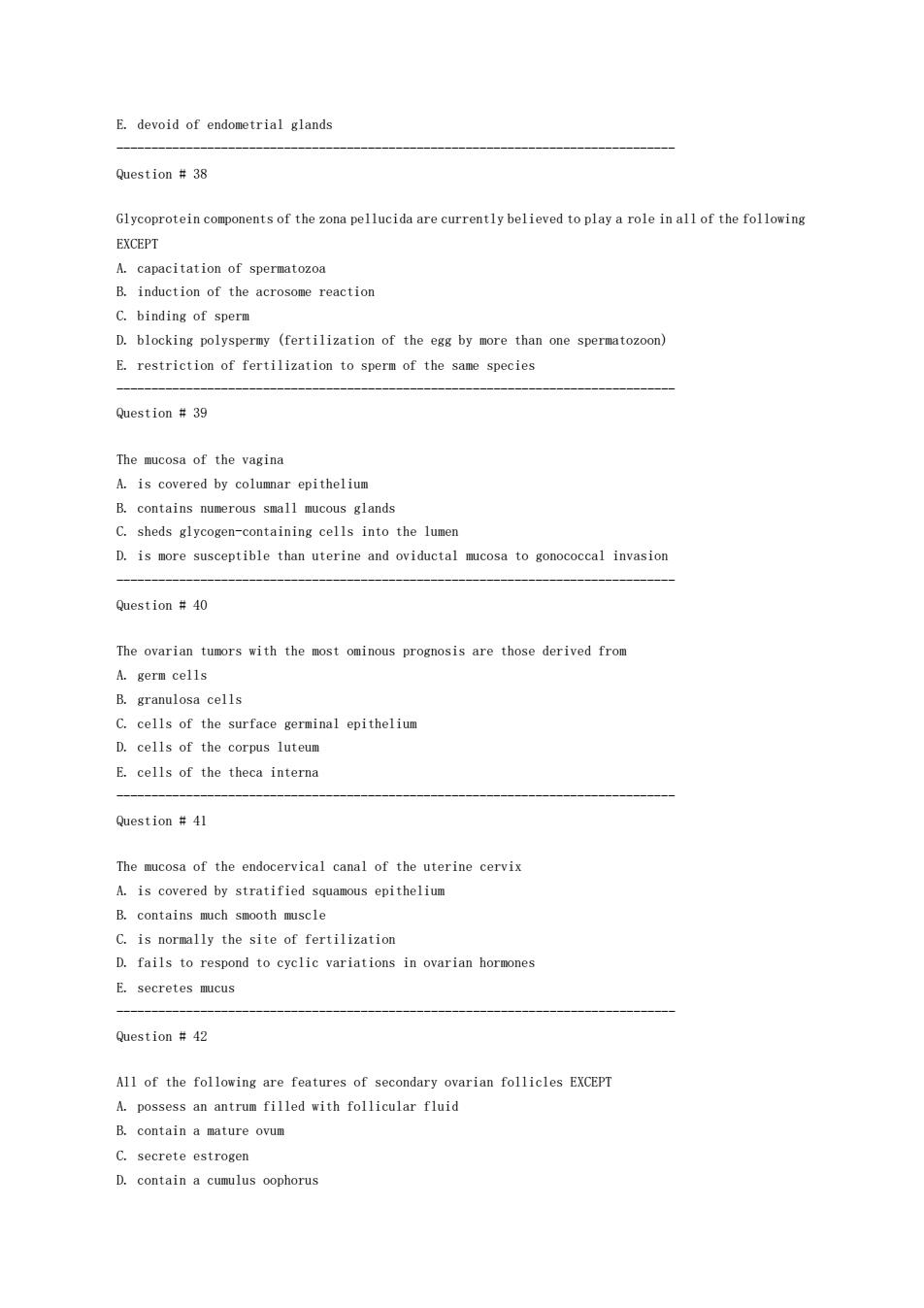
E devoid of endometrial glands Question#38 Glycoprotein components of the zona pellucida are currently believed to play a role in all of the following EXCEPT A canacitation of spernatozoa B.induction of the acrosore reaction C.binding of spera D.blocking polyspermy (fertilization of the egg by ore than one spermatozoon) E.restriction of fertilization to sperm of the sane species Question#39 The mucosa of the vagina A.is covered by columar epithelium B.contains numerous small mucous glands C.sheds glycogen-containing cells into the lumen D.is more susceptible than uterine and oviductal mucosa to gonococcal invasion The ovarian tuors with the aost oainous prognosis are those derived from A germ cells R.granulosa cells C.cells of the surface germinal epitheliun D.cells of the corpus luteum E cells of the theca interna Question 41 The mucosa of the endocervical canal of the uterine cervix A.is covered by stratified squamous epithelium B.contains auch smooth muscle C.is normally the site of fertilization D.fails to respond to cyclic variations in ovarian hormones E secretes aucus Question #42 All of the following are features of secondary ovarian follicles EXCEP A.possess an antrum filled with follicular fluid B.contain a mature ovus C.secrete estrogen D.contain a cumulus oophorus
E. devoid of endometrial glands -------------------------------------------------------------------------------- Question # 38 Glycoprotein components of the zona pellucida are currently believed to play a role in all of the following EXCEPT A. capacitation of spermatozoa B. induction of the acrosome reaction C. binding of sperm D. blocking polyspermy (fertilization of the egg by more than one spermatozoon) E. restriction of fertilization to sperm of the same species -------------------------------------------------------------------------------- Question # 39 The mucosa of the vagina A. is covered by columnar epithelium B. contains numerous small mucous glands C. sheds glycogen-containing cells into the lumen D. is more susceptible than uterine and oviductal mucosa to gonococcal invasion -------------------------------------------------------------------------------- Question # 40 The ovarian tumors with the most ominous prognosis are those derived from A. germ cells B. granulosa cells C. cells of the surface germinal epithelium D. cells of the corpus luteum E. cells of the theca interna -------------------------------------------------------------------------------- Question # 41 The mucosa of the endocervical canal of the uterine cervix A. is covered by stratified squamous epithelium B. contains much smooth muscle C. is normally the site of fertilization D. fails to respond to cyclic variations in ovarian hormones E. secretes mucus -------------------------------------------------------------------------------- Question # 42 All of the following are features of secondary ovarian follicles EXCEPT A. possess an antrum filled with follicular fluid B. contain a mature ovum C. secrete estrogen D. contain a cumulus oophorus

E respond to FSH from the pituitary gland Question#43 An apocrine type of secretion is characteristic of the A.oviductal epithelium B.Leydig cells of the testis C.granulosa cells of ovarian follicles D.lactotropes (mamotropic cells)of the anterior pituitary alveoli of the ammry gland Question#44 Which of the following synthesize(s)androgens as a step in the production of estrogens A Oocvte pucleus B.Zona pellucida C.Granulosa cells D.Theca interna E.Theca externa 1.E2.A3.C4.D5.B6.D7.B8.E9.D10.B 11.B12.D13.A14.A15.C16.D17.D18A19.D20.D 21.D22.D23.C24.E25.A26.A27.D28.D29.A30.B 31.B32.B33.A34.D35.A36.C37.B38.A39.C40.C 41.E42.B43.E4.D
E. respond to FSH from the pituitary gland -------------------------------------------------------------------------------- Question # 43 An apocrine type of secretion is characteristic of the A. oviductal epithelium B. Leydig cells of the testis C. granulosa cells of ovarian follicles D. lactotropes (mammotropic cells) of the anterior pituitary E. alveoli of the mammary gland -------------------------------------------------------------------------------- Question # 44 Which of the following synthesize(s) androgens as a step in the production of estrogens A. Oocyte nucleus B. Zona pellucida C. Granulosa cells D. Theca interna E. Theca externa -------------------------------------------------------------------------------- Answer: 1.E 2.A 3.C 4.D 5.B 6.D 7.B 8.E 9.D 10.B 11.B 12.D 13.A 14.A 15.C 16.D 17.D 18.A 19.D 20.D 21.D 22.D 23.C 24.E 25.A 26.A 27.D 28.D 29.A 30.B 31.B 32.B 33.A 34.D 35.A 36.C 37.B 38.A 39.C 40.C 41.E 42.B 43.E 44.D